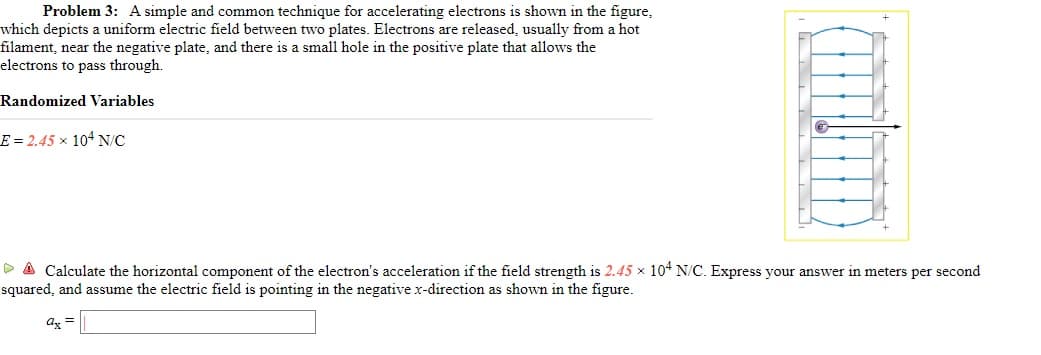Problem 3: A simple and common technique for accelerating electrons is shown in the figure, vhich depicts a uniform electric field between two plates. Electrons are released, usually from a hot ilament, near the negative plate, and there is a small hole in the positive plate that allows the -lectrons to pass through. Randomized Variables E= 2.45 x 10 N/C >A Calculate the horizontal component of the electron's acceleration if the field strength is 2.45 x 10+ N/C. Express your answer in meters per second quared, and assume the electric field is pointing in the negative x-direction as shown in the figure.
Problem 3: A simple and common technique for accelerating electrons is shown in the figure, vhich depicts a uniform electric field between two plates. Electrons are released, usually from a hot ilament, near the negative plate, and there is a small hole in the positive plate that allows the -lectrons to pass through. Randomized Variables E= 2.45 x 10 N/C >A Calculate the horizontal component of the electron's acceleration if the field strength is 2.45 x 10+ N/C. Express your answer in meters per second quared, and assume the electric field is pointing in the negative x-direction as shown in the figure.
Principles of Physics: A Calculus-Based Text
5th Edition
ISBN:9781133104261
Author:Raymond A. Serway, John W. Jewett
Publisher:Raymond A. Serway, John W. Jewett
Chapter28: Quantum Physics
Section: Chapter Questions
Problem 33P
Related questions
Question

Transcribed Image Text:Problem 3: A simple and common technique for accelerating electrons is shown in the figure,
which depicts a uniform electric field between two plates. Electrons are released, usually from a hot
filament, near the negative plate, and there is a small hole in the positive plate that allows the
electrons to pass through.
Randomized Variables
E = 2.45 x 104 N/C
> A Calculate the horizontal component of the electron's acceleration if the field strength is 2.45 x 104 N/C. Express your answer in meters per second
squared, and assume the electric field is pointing in the negative x-direction as shown in the figure.
Expert Solution
This question has been solved!
Explore an expertly crafted, step-by-step solution for a thorough understanding of key concepts.
This is a popular solution!
Trending now
This is a popular solution!
Step by step
Solved in 2 steps with 2 images

Knowledge Booster
Learn more about
Need a deep-dive on the concept behind this application? Look no further. Learn more about this topic, physics and related others by exploring similar questions and additional content below.Recommended textbooks for you

Principles of Physics: A Calculus-Based Text
Physics
ISBN:
9781133104261
Author:
Raymond A. Serway, John W. Jewett
Publisher:
Cengage Learning

Modern Physics
Physics
ISBN:
9781111794378
Author:
Raymond A. Serway, Clement J. Moses, Curt A. Moyer
Publisher:
Cengage Learning

University Physics Volume 3
Physics
ISBN:
9781938168185
Author:
William Moebs, Jeff Sanny
Publisher:
OpenStax

Principles of Physics: A Calculus-Based Text
Physics
ISBN:
9781133104261
Author:
Raymond A. Serway, John W. Jewett
Publisher:
Cengage Learning

Modern Physics
Physics
ISBN:
9781111794378
Author:
Raymond A. Serway, Clement J. Moses, Curt A. Moyer
Publisher:
Cengage Learning

University Physics Volume 3
Physics
ISBN:
9781938168185
Author:
William Moebs, Jeff Sanny
Publisher:
OpenStax


Physics for Scientists and Engineers with Modern …
Physics
ISBN:
9781337553292
Author:
Raymond A. Serway, John W. Jewett
Publisher:
Cengage Learning